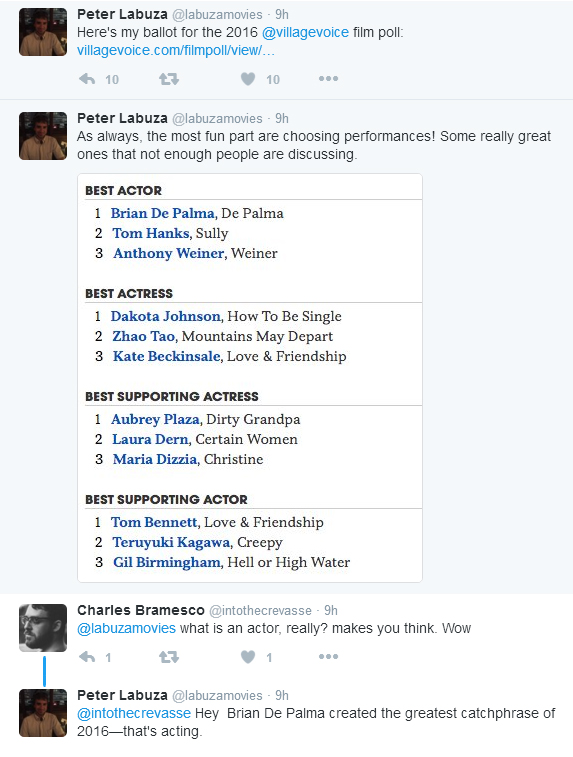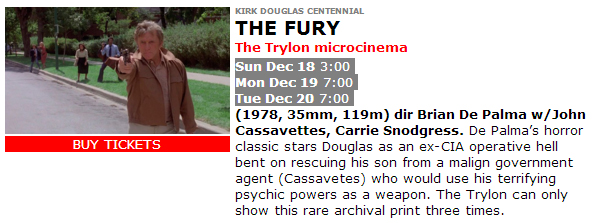IN CONJUNCTION W/CUTS, SUBWAY SEQUENCES "ACQUIRE AN ENERGY & DYNAMISM" THAT WOULD BE DIMINISHED AS SINGLE-TAKE
 As reported here last weekend, Brian De Palma's Raising Cain and Carlito's Way were screened back-to-back Friday afternoon/evening at The Film Society of Lincoln Center, as part of its current series, "Going Steadi: 40 Years of Steadicam." The Lincoln Center series is the cover story of the current issue of Film Comment, which includes an interview with Steadicam inventor Garrett Brown, who mentions Carlito's Way as a prime example of the Steadicam being used to shoot in conjunction with cuts, or edits, to create a dynamic flow of images (as opposed to elaborate single-take sequences). The interview was conducted by John Bailey-- here is the excerpt:
As reported here last weekend, Brian De Palma's Raising Cain and Carlito's Way were screened back-to-back Friday afternoon/evening at The Film Society of Lincoln Center, as part of its current series, "Going Steadi: 40 Years of Steadicam." The Lincoln Center series is the cover story of the current issue of Film Comment, which includes an interview with Steadicam inventor Garrett Brown, who mentions Carlito's Way as a prime example of the Steadicam being used to shoot in conjunction with cuts, or edits, to create a dynamic flow of images (as opposed to elaborate single-take sequences). The interview was conducted by John Bailey-- here is the excerpt:What do you think of movies that use the Steadicam as a real-time technique-- the entire film being shot in a continuous take? I think of a movie like Russian Ark.
Of course I enjoyed Russian Ark, and likewise several more recent, less rigorous examples that invisibly devided the operating chore into more manageable hunks. But they are tours de force and inevitably degrade the stoytelling to achieve a continuousness that non-cineastes might not even notice. I love cuts. Moviegoers don't even notice them, and I loved shooting for cuts with Steadicam. At best, such as in the subway sequences of Carlito's Way, they acquire an energy and dynamism and pure bold kinetic energy that would be inevitably diminished by any attempt at a "one-er." I cherish the Western cinema tradition as is... cuts and all!
"A DEVASTATING ARGUMENT AGAINST HANDHELD"
Earlier this month, No Film School's Emily Buder interviewed Brown, and asked him to name "some of those greatest Steadicam shots which you have not operated yourself"...
Well, I was immediately a fan of the Goodfellas shot. God, there are just tons of them. The one from Boogie Nights I loved. Carlito's Way has some fantastic shots in it. Kill Bill. There's astounding Steadicam in that. And a vast number of foreign films. An inability to think of them as a sign that there are so many that are spectacular. It's like asking somebody, "What are your favorite violin solos in history?" and they flood in on you, the most astonishing ones by this and that artist.The important thing that I learned—and we've all learned—is Steadicam is a rather crappy invention. By itself, it doesn't do a thing. In the hands of a gifted operator, it is an instrument and is of no more use than the skill of the operator. It just barely allows a gifted human being to do this amazing trick: to run along with their ever-moving corpus. Out the other end comes an astonishing dolly shot smooth as glass.
Not only that, it's a dolly shot that can do stuff a dolly can't. As a fingertip operation, you could put the lens precisely where it wants to be, not just in dolly to the right, but in French curves. It would drive a dolly group crazy. Instinctively putting the lens where you want as boom up and down, and traverse left and right and aim, pan, and tilt. Everywhere your feet can take you and your arms can put this thing, there is the potential path for a lens. But the point isn't to be flashy.
The point is to let these storytelling shots show you what you—the viewer—ideally would love to see; where you would put your eye if you were standing on that set looking. We do this a million times a day. Human beings are fabulous camera operators of our own eyes, and our own eyes are superbly stabilized. When you run, you don't see a jerky shot. You see a very smooth Steadicam shot. We instinctively lean left and right, stand up and move around, to see what we want to see. I think that is a devastating argument against handheld: human beings don't see in the shaky way that handheld presents the world. In fact, it's stupid that your audience would see a shakier vision than your actors would see.
There's a strong argument, I think, for at least being as stable as your own magnificent little internal Steadicam. Your inner ear tells your eye muscles how to move to eliminate the bumps. Look straight across the room and fix your eyes on something and shake your head up and down violently. It just sits there, right? Shake your head side to side. It just sits there. But if that was a camera, you couldn't watch it. Now, watch this: tilt your head to one side. The room does not tilt. Your brain is conditioned to perceive the room as level no matter what angle your eye is. Why? Because evolution didn't find that of any interest for keeping us alive. It's really fundamental stuff. I could be a great bore on this subject, but I'm not a fan of handheld, and that's why the Steadicam exists. I wouldn't have been able to put it in those terms 40 years ago, but it's become quite clear to me.
When you dart your eyes around left or right and fix on something and dart to the other side of the room and look, there are only maybe 30% or 50% of Steadicam operators that can do that with a Steadicam. There's almost nothing else that can do what is called a saccad. A saccad is when you dart your eyes from one side of the room to the other.












